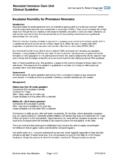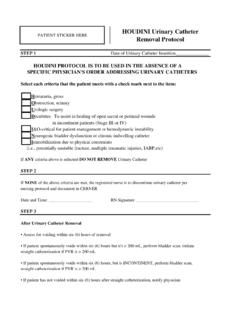Transcription of Neonatal Intensive Care Unit Clinical Guideline …
1 Neonatal Intensive Care Unit Clinical Guideline pneumothorax BACKGROUND A pneumothorax may be an emergency when the air collection is under pressure (a tension pneumothorax ). When it causes an acute Clinical deterioration it may be necessary to drain the pneumothorax by needle aspiration and/or chest drain insertion PURPOSE To drain air from the pleural cavity allowing the lung to re-inflate thus improving baby's condition/ventilation. MAKING THE DIAGNOSIS. Suspect a pneumothorax if increase in respiratory distress and/or diminished chest movements sudden deterioration with desaturation circulation may become compromised blood gas shows hypoxia, respiratory and/or metabolic acidosis. Clinical signs may be minimal unequal or decreased air entry asymmetrical chest movements tachycardia fall in blood pressure transillumination with a cold light. Useful but can be unreliable in o extremely low birth weight infants (may be false-positive ).
2 O infants with increased thickness of the chest wall term infants and oedema o infants with pulmonary interstitial emphysema (who may show a 'false positive'. result). CXR will confirm the diagnosis but in an emergency is usually too time consuming. Anatomy it is essential to mark the skin with a permanent marker pen to ensure accurate placement. In small babies, transillumination may help with rib counting. Chest drains are normally placed through the 4th or 5th intercostal space, above a rib (to avoid injury to intercostal vessels which run under the rib) in the mid axillary line Our current practice is to use the pigtail chest drains, due to their ease of insertion , Clinical effectiveness in treating the pneumothorax and improved comfort for the baby. However staff should be familiar with the more traditional catheter-trocar chest drains. 1. Needle Aspiration of Chest Needle aspiration is an emergency procedure only.
3 Care must be taken to avoid laceration of the lung or puncturing blood vessels. Equipment 21 gauge (green) or 23 gauge (blue) butterfly needle 3 way tap 10 ml syringe Alcohol skin wipe 1 pair sterile gloves Procedure Infant supine, prepare area with alcohol wipes Insert needle into the pleural space (directly over the top of the rib in the 2nd or 3rd intercostal space in the mid-clavicular line) until air is aspirated into the syringe, then expel air through the 3-way stopcock Ongoing Care Following needle aspiration insertion of an intercostal catheter is usually required for on-going management. 10ML. SYRINGE. 3 WAY TAP. BUTTERFLY. NEEDLE. 2. insertion of Cook Fuhrman Pigtail Pleural Drain using Seldinger Approach. Indications: pneumothorax or Pleural Effusion. We stock 2 types of Cook Fuhrman pigtail pleural drain sets 1) -use for >1501gms 2) -use for <1500gms Both catheters have 6 side ports Advantages of Pigtail drains Less traumatic insertion and fewer complications.
4 Suitable for very preterm babies Disadvantages May Kink or obstruct due to its softer consistency. Components of pleural drain pack 1) 18 G introducer needle 2) J-wire guide (Length 40cm). 3) Dilator 4) Radiopaque pigtail catheter with 1cm markings ( First marker at 7cm). 5) 3-way stopcock 6) Multipurpose tubing adapter You will also need 5ml syringe, mosquito artery or similar forceps & a sterile procedure pack long line pack Preferred drain site: 4th or 5th intercostal space, above a rib (to avoid injury to intercostal vessels which run under the rib) in the mid axillary line, well clear of the nipple. Ensure adequate analgesia and sedation Morphine +/- Midazolam 1) Mark the insertion site with a permanent marker pen. 2) Glove and gown as per unit Guideline for aseptic technique 3) Position the patient supine with procedure side tilted slightly upward 4) Prep the skin site as per unit Guideline 5) Identify correct landmark 6) The use of a transparent sterile drape enables continued visibility of landmark 7) Lignocaine local infiltration.
5 Not more than 1ml 8) Assemble needle & syringe and attach mosquito forceps distal to needle tip to reduce risk of inserting it too far into chest cavity. 9) Slowly insert needle with attached forceps at 90 degree angle to the rib. Gently angle anteriorly for pneumothorax , aspirating until air is obtained or if draining a pleural effusion, aim posteriorly and aspirate until fluid is obtained. 10) Remove the syringe and advance soft J end of J-Wire, using its introducer through the needle to a length of 5cm into the chest (The J wire is very long, be aware of asepsis). 11) Remove the needle gently and hold on to the J-wire where it exits the chest wall as soon as the needle tip is out. This is to avoid accidentally removing the J-wire. 3. 12) Advance the dilator over the wire using a rotating action to pass through the chest wall. Then withdraw the dilator, again securing the J-wire to avoid inadvertently removing it.
6 13) Feed the pigtail catheter (coiled porthole end first) over the J-wire and advance into the chest cavity, up to the first black mark (7cm) for the extreme preterm babies & at the 2nd-4th mark for bigger babies based on measurement of targeted position. 14) Remove the J-wire 15) Use steri-strips to anchor pigtail to the skin. 16) Place Tegaderm dressing over insertion site. 17) Connect catheter to drainage unit using adapter and 3 way stopcock. 18) Request CXR to confirm position of catheter. 4. Catheter - Trocar Chest Drain insertion EQUIPMENT. 1. Sterile chest drain pack 2. Sterile gloves, gown and drapes Non sterile tray containing 1. Trochar + cannula size 8 x 2 size 10 x 2. 2. T extension with luer lock 3. 3 way stop-cock (connector). 4. 1 Vygon connector 5. 10 ml syringes x 2. 6. 1 ml syringe x 2. 7. Needles 25g (orange) x2. 8. Butterfly needle 23g (Blue) x2. 9. Disposable scalpel x 1. 10. Disposable scissors x 1.
7 11. 3/0 black silk sutures x 2. 12. Heimlich chest drain valve x 2. 13. Sentinel Seal chest drainage unit ALSO. Steristrips x 2. Tegaderm x 2. Chlorhexidine aqueous solution (Pink ). Bottle of sterile water Extra swabs x 3. Extra dressing towel x 2. NB Have low pressure suction pump available 5. PROCEDURE. Inform parents where possible Sterile gown and gloves Aim to maintain the infant's temperature. Place the infant with the affected side uppermost and the arm extended above the head. Ensure limbs are adequately restrained. Monitor infant's heart rate and oxygen saturation level The intercostal catheter ( ICC , chest drain ) is usually inserted in the 4th or 5th intercostal space in the mid-axillary line. This corresponds to a point 1-2cm lateral to and below the nipple. The incision must be well clear of the nipple. Mark location with pen. Prepare the field with chlorhexidine (pink solution). Select intercostal catheter size Infants > 1500g 10 or 12 Fr < 1500g 8 or 10 Fr <1000g 8 Fr Place sterile drape in position Infiltrate the insertion site with 1% Lignocaine - 1mL (max).
8 If baby is ventilated and on a morphine infusion can also give a bolus dose of 100 micrograms per kg, which can be repeated if needed. Using small scalpel blade make a 1cm incision through the skin and subcutaneous tissue The preferred technique is as follows. Using straight mosquito forceps to bluntly dissect away the subcutaneous tissue and intercostal muscles, the parietal pleura is reached. Aim to dissect a passage just above a rib border in order to avoid the neurovascular bundles running below each rib. Open the parietal pleura by blunt dissection. At this point the hiss of air escaping the pleural space may be heard Remove the trocar from the ICC and grasp the distal end with the curved artery forceps. Direct the tip anteriorly as well as superomedially so that the tip lies beneath the anterior chest wall. Advance the ICC into the pleural space 2 - 4 cm, depending on the baby's size. Connect the ICC via connector to a Heimlich valve or an underwater seal drainage system (Sentinel Seal), and note whether the fluid is swinging and/or bubbling.
9 Condensation within the catheter may be seen when within the pleural space. Place a single stitch through the wound so that the skin is drawn snugly around the ICC. Purse string stitches are not used as they leave an unsightly scar. Wrap the ends of the suture around the ICC several times and tie securely. Secure the ICC to the chest wall with Tegaderm. Position it to maintain the anterior position of the ICC. Secure positioning is important to minimize trauma to intrathoracic structures due to movement of the extrathoracic portion of the ICC. TEGADERM. 3 WAY TAP. HEIMLICH VALVE. 6. Ongoing Care Check the tube position and resolution of the pneumothorax by transillumination and x- ray urgently. The need for ongoing analgesia is based on an assessment of physiological and behavioural responses associated with pain. Instructions for removal The decision to clamp off and/or remove a chest drain should be discussed with the attending consultant 7.
10 Nursing staff ACTION RATIONALE. Inform parents of need for procedure Re-assure and explanation of need for May have to be done in retrospect in not intervention present Wash hands open sterile packs onto Infection control/prevention of cross aseptic field infection Ensure baby is receiving adequate For comfort and pain relief analgesia Monitor general condition of baby For recognition of any including- record vital signs HR, Resps, Improvement/deterioration in condition Temp, SAO2 B/P. Position baby as requested by Dr. To aid correct insertion Assist Dr. to secure the drain in position To prevent displacement and further and attach T-Piece, 3 way tap, Vygon trauma connector Attach Heimlich valve OR. Set up Sentinel Seal chest drainage unit (see below). If more than one drain is required, label each one with number in order of insertion Observe position of drains, Fluttering of To determine improvement or the valve and any secretions present deterioration in condition Always clamp off drains if turning or For safety and comfort lifting the baby, ensuring they are unclamped when baby is settled Inform parents when procedure is Parental re-assurance/reduce anxiety completed Spencer wells forceps should remain at For safety the cot-side in case of disconnection or malfunction 8.








